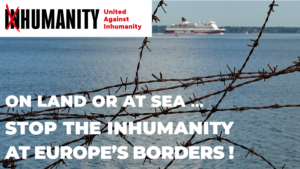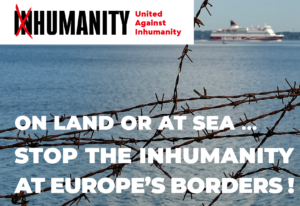“Engage! Do not isolate Afghanistan as hunger, Covid, long-standing gender inequality and impunity add to the threats that harm Afghans a as the Taliban impose multiple strictures”.
The Centre for South Asian Studies and the Edinburgh Centre for Medical Anthropology at the University of Edinburgh, in collaboration with United Against Inhumanity (UAI), organized a virtual panel event “What’s Next for Afghanistan? Evolving implications for safety, gender equity and urgent humanitarian action” on 31 August 2021. The purpose of this event was to open and broaden a discussion on the fast-moving Afghan crisis to facilitate a more nuanced understanding of the situation and to highlight the dangers of knee-jerk reactions that portend harm for Afghans. The panel was motivated by a commitment to understanding Afghanistan beyond the widespread event-based reporting in media and also beyond its stereotypical image of a timeless society. The overall aim of the event was to call for global solidarity including support for urgent humanitarian action.
A total of 80 participants took part in the event. Jeevan Sharma from the University of Edinburgh convened the meeting and facilitated the panel discussion.
The three female panelists, Sippi Azarbaijani-Moghaddam, Aunohita Mojumdar, and Norah Niland have worked in, and on, Afghanistan for a total of 40+ years; their presentations contributed to a useful and energetic discussion on current and potential realities facing Afghans in and outside the country. The event did not have any Afghan panellists given the evolving and unpredictable security situation at that time. All underlined the importance of not diluting engagement with Afghan civil society actors nor treating the country as a pariah state as this would be greatly detrimental and add to the 50% of the population that is already at-risk and in need of humanitarian action for survival.
Sippi Azerbaijani-Moghaddam noted that the international media only gives us a partial picture of Afghanistan. In recent weeks, we have heard numerous horror stories of killings and stonings of women. There has been a great deal of hysteria and fake news. But the complexity of what happens on the ground is seldom reported including when stories do not fit dominant Western narratives. For example, nobody ever reported a firefight in 2016 between a group of women from an extremist Central Asian militant group and the Taliban in Zabul province. Some of the women had babies strapped to their backs and the Taliban hesitated to shoot back. So this was indeed a women’s story, one that showed women in a different light, namely female combatants who had taken up arms against the Taliban. The media lens is very laser-focused on a very specific group of people. It’s important to realize that Afghan women who fall outside this very narrow lens mostly remains unseen.
The Taliban are now providing assurances and promises that there will be negotiations and that women will be allowed to carry on many activities within the bounds of Sharia Islam. These assurances are most likely designed to throw us off our guard. They are managing their public image. A lot of people have the expectations of doom and gloom that we’re going to go back to the period that the Taliban were in power in Kabul. To a large extent, this is because we have had a period of twenty years of narratives pushing against Taliban restrictions of the past. It has been like a self-hypnosis loop. For many people, it has been very alarming that the Taliban have made a come-back because they have created a nightmare bogey man out of them. The question is whether they were the monsters that did terrible things, and how much people were sort of open to telling themselves about these restrictions.
When the Taliban took over in 1995-1996 they were reacting to a situation of extreme violence and extreme lawlessness. There was massive factional fighting among Mujahedeen groups and violence against women. In terms of what it was actually like for girls and women, there is a narrative, for example, that there was no girls’ education under the Taliban. This is incorrect. The regime did not have resources–unlike in the past 20 years. There was no funding for education across the country, there was no money to pay teachers or build schools. There was no external help to run the country. A Danish NGO where Sippi worked, at the time, was building schools for girls. In many areas girls, up to a certain age were allowed to go to school.
Before the arrival of the Taliban, aid agencies were having problems with the Mujahideen in terms of getting girls into school. To some extent, cultural norms have now shifted. It was possible to work – again depending on the budget to segregate men and women and to pay salaries. Women were very much encouraged to work in health care; they were allowed to work for NGOs, the limitation was always the amount of salary that was available to hire people. There were even businesswomen still working under burqas in Mazar.
Jumping to the future, Afghanistan has changed a great deal and people have become used to very different situations. Chances are that the Taliban will adapt as much as they can within the sorts of restrictions that they have due to other political and military issues and budgetary issues. Institutions like Parliament, with the attendant elections, are run largely by donor money. Likewise, gender focal points and many female positions in ministries are funded by donors. Will these jobs survive? It will largely depend on whether funds are available for segregated offices or not.
Media is different. Women’s role in the media is where the biggest loss, will be felt where women suddenly become invisible. For people with money, change will be harder: entertainment, shopping malls, etc. may well close down, but will lives change dramatically for the mass of rural people 60% of whom live very close to or below the poverty line. And of course, things will be much worse if another bout of conflict ensues. This would be horrendous and devastating.
Aunohita Mojumdar focused on Afghanistan and the region. She noted that the importance of the region lies in the similarity of challenges and opportunities – even though most challenges assume an acute form in Afghanistan. Issues in Afghanistan are viewed almost entirely through the political lens of strategic interests by the international community (the political view in various countries). Therefore issues are taken up or dropped depending on which regime is in power in Afghanistan.
Quoting from the UN report Silence is Violence on violence against Afghan women, she recalled how violence against women in Afghanistan inhibits the participation of women in public life. The report identified perpetrators as anti-government elements, local traditional and religious power holders, women’s families, communities, in some cases government authorities. Some of this sounds almost eerily familiar in terms of the discussion that has been taking place in the last few weeks, which Sippi described as one of horror and hysteria. But the report is from 2009 and was one of the sharpest UN reports on the continuing impunity for violence against women and the lack of voices against it. Drawing attention to this report is important because for the last 20 years the focus has gone off subjects that were perhaps not considered politically. The issue of women’s rights has been turned on and off like a tap for instrumental reasons. And now we worry that the tap is being turned off again. At the launch of the report, Bollywood star and activist Shabana Azmi had been invited and she spoke eloquently of the similarity of challenges faced by women in India.
The women’s issues have a cultural dimension. An example is the wearing of purdah by women in villages in the Northern Indian state of Haryana in some Hindu communities. This is not seen as problematic. However, when purdah is in the form of a burqa it assumes other political connotations related to religion, terrorism, and the Taliban regime.
The last few years have also seen rollbacks of women’s rights as conservatives put in place by the international community have pushed back against the equality, safety, and liberty of women. One needs to understand these issues in their complexity rather than through a polarised lens – to better address the issues when they become worse as they probably will under the Taliban.
Another example is that of the narrative about minorities: the perception has been that it is non-Muslim minorities who face the brunt of Taliban restrictions whereas actually, it is Muslim minorities such as the Shia Ismaelis and the Hazaras who have suffered most. The Taliban were forcing their religious diktat on Muslims and not on Hindus and Sikhs.
The massacre of hundreds of Hazaras in Bamiyan in 2001 evoked little international comment compared to the outrage over the destruction of the Buddha statues. Yes, a lot of ground may be lost now, but a lot was also lost during the past 20 years. The space which was available in 2001 for new initiatives, including women’s participation in Parliament, was slowly eroded.
One must move beyond regime-oriented perceptions and unpack issues if we are to address them and support Afghans in their efforts. Afghanistan cannot be reviewed in binaries – but must be seen in all its complexity and not through a polarised debate as is the case now. Who knows for example that the Taliban banned odious practices which were prevalent in southern Afghanistan such as the bartering of brides? This is not reported in the mainstream media. So this is not about condoning anything that the Taliban has done in the past, or may do in the future. It’s about understanding complexity.
The region has been kept at bay by America according to who is seen as inimical or not e.g. Russia, Iran, China, and India. It is now being described as a win-lose battle. One must unpick the interests and see the areas of convergences as well as divergences of regional countries to ensure some cooperation on issues. Afghanistan is not a place to be won and lost by anyone and even if our governments are in disagreement with any government that will take shape there, I think we need to go beyond the government: there is also enormous space to operate within Afghanistan.
While it is important to focus on those who are leaving or desperate to leave Afghanistan, attention needs to be paid to humanitarian needs. There is a huge shortfall of funding for humanitarian needs. There is a drought, there is COVID which is likely to exacerbate because of the conflict, there are food and shelter needs for the displaced which are urgent. The international community is talking about how it is deeply concerned about the situation. Donors could start by meeting under-funded humanitarian needs. If they have concerns about the new authorities, they can channel their money through the humanitarian agencies which are continuing to function in Afghanistan.
Norah Niland, the third and final Panelist to speak, focused on the humanitarian situation looking at contextual realities and issues that need to be borne in mind to be effective in saving lives and alleviating shocking levels of human suffering.
Afghanistan has been a situation of humanitarian concern for four decades, dating from the onset of armed conflict in 1979. Norah noted that war has been the overriding factor in driving humanitarian needs for decades. With the arrival of the Taliban in Kabul and, notwithstanding the presence of ISIS-K, warfare as a central concern may be overtaken by fear of repression, continuing human rights violations, and uncertainty about the future. Other drivers of humanitarian need that are not new include a deepening drought and Covid-19, dysfunctional governance, and long-standing gender, and other inequalities that have compounded growing levels of displacement. Increasingly restrictive and fatal deterrence measures by Europe and other states continue to undermine the right of all to seek asylum.
There is much discussion as to whether the Taliban have changed and a lot of understandable concern about the implications of their rapid arrival in the capital on 15 August. In this regard, it is worth noting that the Taliban took control of Kabul and some other cities without a fight; this helped avoid the kind of chaos, including rape and other forms of sexual violence that often characterized abrupt changes of power in Afghanistan.
When reviewing the current situation in Afghanistan it is worth noting that it is a much-changed country to what it was in 1979 or, indeed, 1996 with the Taliban first took power in the capital. The transformational change includes the rise of independent media, many Afghans use mobile phones, more women than before are working outside the home, there is much-improved access to health care and millions of kids are going to school. This has contributed to the emergence of a new educated class, particularly in urban areas that are also home to millions of the poor who have fled the countryside in search of safety, livelihoods, and a better future.
Norah provided a long list of facts and figures about the unconscionable number of war dead, the dire state of the economy, unheralded levels of poverty with half of the population of some 39 million dependent on humanitarian action for survival. Food insecurity means some 14 million people are hungry; more than 3 million children face severe malnourishment in a country where two-thirds of the population is less than 25years of age. Millions are internally displaced while Afghans are the second-largest group of refugees in the world with the majority hosted in Pakistan and Iran.
She noted that, as before, robust attention to the protection dimension of humanitarian action will be critical to safeguarding life and strengthening coping mechanisms. Humanitarians have long experience in negotiating and working with the Taliban and many aid agencies had already received a green light to continue as before.
In conclusion, she noted that everyone concerned about the current and fast-moving situation needs to be wary of, and advocate against, their governments treating Afghanistan as a pariah state. Cutting funding for vital services, or blocking access to US$9 billion Afghan reserves held in US banks, would be a dangerous and deadly strategy. She appealed for continued engagement and support for all those Afghans struggling to maintain civil society action and to maintain hope in the energetic, intelligent, and determined younger generation and others who have long laboured for a fair, inclusive, and peaceful Afghanistan.
Discussion
The presentations were followed by comments and a lively debate that touched on important issues such as how to avoid the focus only on cities and thus neglecting the problems of rural areas and what are the best approaches for engaging with the new authorities to ensure that the gains of the past 20 years are not lost. Panelists noted that the shadow governance system that has been functioning in many parts of the country for years already has not been discussed in mainstream media. Nor the fact that the Taliban want to portray themselves as a people’s movement, as a popular movement much more in touch with the people than the previous government. Also, Afghanistan mustn’t be treated as a pariah state. The humanitarian needs are tremendous; it is important that all of us engage, both as individuals and as communities, and push our governments to do so.
Asked about what could be done to ensure that human rights are not rolled back by the reactionary policies of the Taliban, panelsits stressed that outsiders and donors should back away from the notion that we can go into other countries and reorder them and turn them upside down so that they’re more like us. Whether it’s Afghanistan or Azerbaijan or Albania that abuses of individuals, human rights violations, always need to be addressed, but the way we go about it, perhaps needs to be rethought in the 21st century. The institutions of the defeated regime were no paragons of human rights. Debates in parliament showed how power structures were often inimical to women’s rights. For example, parliamentarians voted down support to safe houses for women, because they said a safe house was immoral. Right now there’s a focus on women’s rights because the Taliban are back and there is a lot of media interest if not hysteria. A more comprehensive look at the realities is perhaps what would be useful.
The issues of drought and climate change came up in various questions. Traditional irrigation systems, including underground karezes and water management systems, are no longer sufficient and the World Bank and others (including poppy farmers) have introduced major unsustainable pay-for-irrigation schemes and solar pumps that are drying up the water table. These will have deleterious effects in the long run as climate change increasingly affects Afghan farmers. A long-term ecological disaster is brewing.
Issues of displacement and the rural-urban divide were also raised. One comment was about how rural livelihoods, based on agriculture, are not sufficient to feed many rural families. So people look for wage labor away from their village and there is a lot of movement back and forth to the cities. Over the past 20 years, as well as in preceding decades, the movement of people and ideas from within and outside the country has changed people’s views and aspirations, also facilitated by the fact that everybody has access to mobile phones. The distinctions between rural and urban are becoming more complex. Many people are becoming “rurban” rather than purely rural and this has implications that the Taliban will have to take into account.
Various participants commented on the nature of Taliban governance, then and now. Again, things should not be perceived as black and white. There is a narrative that the Taliban don’t know how to govern and that they’re a band of warriors. If we go back to the late 90s, Taliban Afghanistan was seen by many as a failed state that was supporting terror and that was not capable of running the country. There’s a counter-narrative to that and although the Taliban had very few economic means they set up ministries that worked to a certain extent, the government was there and it was not corrupt. They were committed to trying to address some of the issues of the population, they were not simply violent and repressive, it was much more complicated than that.
Various participants felt that rather than shunning them and pushing them into a corner, it was necessary to engage. Because the international community, including Washington in particular, and the World Bank are likely to withhold the money that belongs to Afghanistan. This is going to have tremendous knock-on effects on the population if basic services collapse in the coming months.
One participant who runs a humanitarian agency currently operational in Afghanistan noted that access and engagement with the Taliban were minor problems compared to the lack of resources. There were philosophical challenges around principles that needed to be addressed in due course but the main challenges were very practical: how to get staff and supplies into the country, how to access cash to pay staff, etc. His agency worked in rural areas and there had been no major change in their modus operandi. Caution and pragmatism seemed to be the best way forward.
[1] See: https://www.csmonitor.com/World/Asia-South-Central/2009/0708/p06s13-wosc.html
Photo Credit: Women with child – Herat, Afghanistan by Marius Arnesen via Flickr











